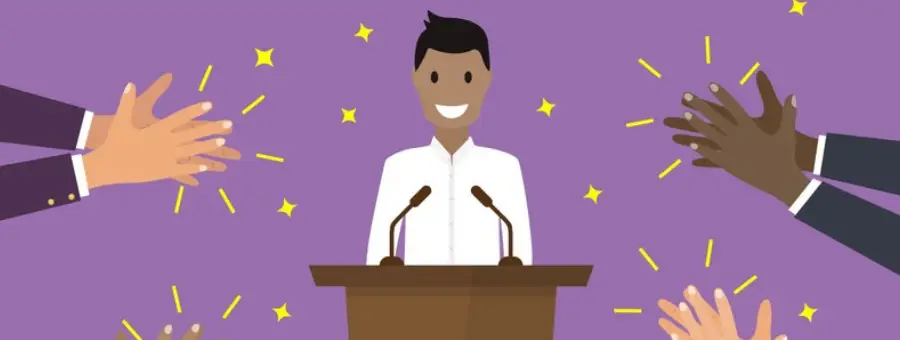
It’s important for many people in business and other organisations to have good presentation skills and to be able to deliver an effective presentation. The purposes of presentations can vary, including conveying important information and messages, influencing thinking, changing behaviours, getting a decision, even just to entertain.
This high performance action lists steps we recommend you follow to deliver a great presentation.
The basics:
Some basic steps are covered below, just to be complete:
- Do your preparation of the content thoroughly. You don’t have to come through as an expert in all aspects but you really shouldn’t be caught out unwittingly.
- Know who the audience is going to be … number, backgrounds, roles, particular interests, etc. This information should impact both the content, presentation style and methods adopted.
- Rehearse the presentation, in front of others, including timing and the total time taken. There is not much worse than running out of time, going over time, or finishing too early.
- If you are going to use background notes for your own reminder purposes, then do so subtly (not in ways that disturb the flow nor ‘look’ of the presentation by having to ravage through them to find information) and deliberately only occasionally (e.g. “Here’s something worth reading out in detail …”).
- If you are going to use ‘tools’ then make certain they work! Powerpoint, digital pointers, remote mouse, video’s, or anything else. It looks bad and disturbs the flow if any of them don’t work.
The higher level aspects:
- Don’t be a slave to your PowerPoint slides. Audiences everywhere have been trained to sit there and watch (voluminous) slide presentations. That makes the presentation methodologically the same as everyone else’s, so don’t be tied so much to that. Sometimes don’t even use PowerPoint. Just converse. Make a point that you’re not going to use slides … some audiences will applaud you just for that!
- Try to ‘connect’ with the audience inside the first few minutes. First impressions are formed quickly but it does not matter if they aren’t positive right at the start; it matters what people are thinking and feeling by the end. However, don’t allow an audience to go too long before you are confident they are engaged. If you don’t connect inside, say ten to fifteen minutes, then it’s going to difficult beyond that. So, if what you are doing is not working you must change it … by altering the content or the approach. This, of course, means you have to be genuinely watching and perceiving the audience’s reactions and engagement, and not just motoring through your presentation ignorant of how they are feeling.
- Scan the entire audience every few minutes. Even for very large audiences, it’s important to make them feel you have contacted their eyes by frequently looking in their direction. Inexperienced presenters often concentrate on those seated directly in front of them or on those who are more vocal in the audience, and don’t have eye contact with everyone else. Those not being ‘eyed’ will drift off too easily.
- Don’t try to be funny if you’re not. It doesn’t work.
- Three components make up the effectiveness of a presentation: Content, Presentation skills, Emotion. The sum total must be powerful. Emotion can be passion, humour, belief, etc. Imagine that the total of the three components has to add up to a score of 100. If your content is really powerful and interesting, you might rate it at 70 … so, the presentation skills and emotion become relatively less important, having to add up to 30. But if the content is valid, without being exceptional, and you rate it at 40 then your presentation skills and emotion (from you or solicited from the audience) has to add unto 60. Be aware of these three components so the presentation is powerful as a package.
- Don’t ‘promote yourself nor (your) products. Presentations are not forums for directly doing this. Sure, they can serve to promote you, what you do and your products, but that should be indirect and skilful, not outright self promotion. That’s tacky and can really lose an audience. Feel free though to use some examples of where your suggestions / offerings / products have helped others, as long as you do so in ways that are useful to the audience and come through humbly from you.
- Test audience engagement, frequently. It’s sad to watch some presenters not even notice that their audience has not switched on or is starting to switch off. Watch them, ask them to respond to quick questions, ask them if they get the point, etc. That is, rely on both your perception as well as explicit testing.
- Always make yourself available to the audience at the end of the presentation and for significant time, not just for a few minutes. Many people want to engage after a presentation, either to ask questions, to say ‘Thanks’, to debate, or to provide feedback. Whatever the reason for them wanting to speak with you, make it easy and give them adequate time. It’s respectful and productive.
- Include practical suggestions for your audience. Even use the phrase ‘This is an important takeout’. You will often see people sit up and take more notice, or even write it down when you prompt them like that.
- Like it or not, if your presentation is not entertaining, you’re making it harder to have an impact. People don’t necessarily attend presentations to be entertained but they participate and engage much more readily if they are. So, always consider whether your presentation is entertaining.
- Move around the room. A presenter who stands / sits in the one place is missing an opportunity to keep the audience’s interest. Moving around causes the audience to move their heads, necks and eyes, as well as their bodies (that may sound trite but it isn’t). If you are not using a microphone the change in volume as you move closer or further away from members of the audience also causes variation in their engagement with you (notice how people engage more so as you approach).
- It is extremely important to vary your volume, tone and speed of speech … for variety and for emphasis. Lowering volume to a whisper is powerful, as is high level volume. Tones can be friendly, casual, intense, passionate, etc. Use the full gamut.
- Speech should not be punctuated by ‘um’ or ‘err’. Train yourself out of this by practice if you have this (bad) habit.
- Use anecdotes, examples and stories. It makes the presentation more interesting, more powerful and real world. Never come through as being a ‘know-all’ as distinct from knowledgeable. They are different. The former will turn the audience off and the latter will entice their interest.
- Use power statements throughout the presentation. For example, “This is one of the most important …”, “This one fact will …”. Such statements serve to draw the audience in.
- Don’t be afraid to state your position. For example, “I truly believe that …”. Such statements give an impression of strong self belief in what you are presenting and that is much more likely to transfer to the audience.
- Some words are proven to be powerful, like it or not. Some of those words are: New, Guarantee, Proven, Free, Invention, Money, You, Research. Use a selection of them for impact when appropriate.
- Encourage interaction with the audience but you need to do so skilfully. You simply can’t let anyone from the audience dominate nor take the presentation off track. Courtesy is the key to being able to handle those sorts of situations.
- Video yourself, critique yourself and have others critique you from the video. Do this with some regularity.
- “Men are from mars. Women are from venus.” tells us to emphasise feelings for women and thoughts for men (it says a lot more than that, of course, but this aspect is particularly important in presentations). Factor this in to your presentation phrasing. For example, “How do you feel when …?” versus “Think about how it might impact … “
- There are 3 ways we give and receive messages, and learn from other people: Visual – seeing; Auditory – hearing; Kinaesthetic – experiencing / being involved. So it’s best to cover all three bases in your presentation. Content should be shown / seen, heard / discussed and experienced so that visual’s, audio’s and kinaesthetic’s are all catered for in the one presentation.
Previous Newsletter Articles
Contact Us
1300 022 270
enquiries@myabbs.com.au
Book An Appointment




